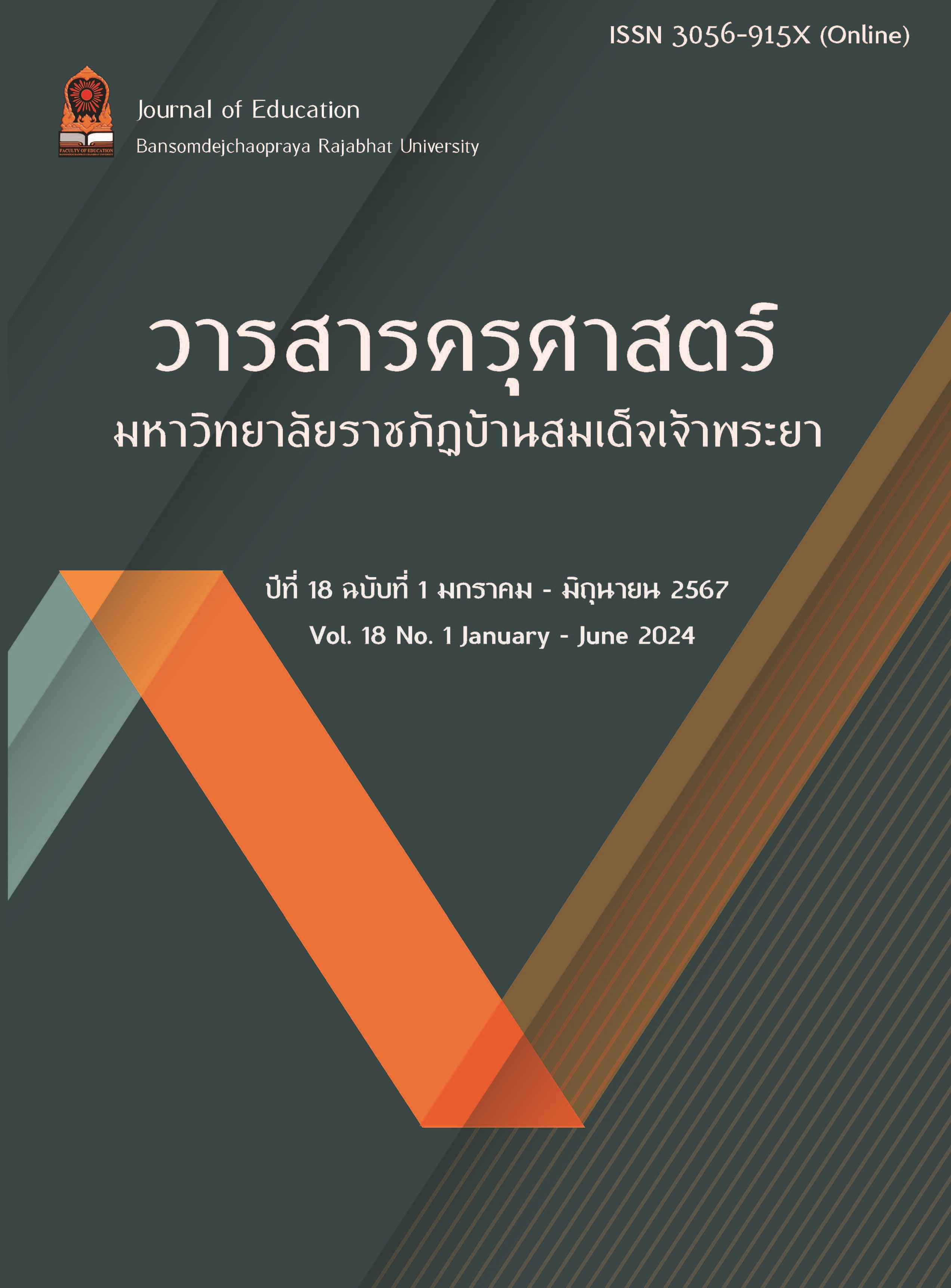Development learning outcomes Art and Thai dance learning group about Natayasab by using cooperative STAD techniques with Prathomsuksa 4 students.
Keywords:
cooperative learning, STAD technique, , learning outcomes About dance vocabulary, Wat Pong SchoolAbstract
The objectives of this research were: 1) to develop learning outcomes 2) to determine learning enhancement; and 3) to determine students’satisfaction toward learning by using cooperative STAD techniques for Prathomsuksa 4 students. Research methodology was quasi -experimental research. The population, Prathomsuksa 4 students in the second semester of the academic year 2023 Samples, Prathomsuksa 4/1 students totaling 40, were obtained via simple random sampling method. The instruments used for data collection were: 1) content of Thai dance about Natayasab; 2) lesson plan; 3) achievement test; and 4) questionnaire of students’ satisfaction. Statistics used for data analysis were percentage, mean, Standard Deviation, and class normalized gain.
The result of research were as follows:
1) learning outcomes of Art and Thai dance learning group about Natayasab by using cooperative STAD techniques After studying above, the standard was 25.08 , amounts to 83.58%.
2) learning enhancement of Art and Thai dance learning group about Natayasab by using cooperative STAD techniques After studying above, the standard was 0.74 (<g> = 0.74).
3) Students’ satisfaction toward learning by using group relations techniques, overall and in every aspect, was at high level.
Downloads
References
กระทรวงศึกษาธิการ. (2551).หลกัสูตรการศึกษาขั้นพื้นฐาน พุทธศักราช 2551.กรุงเทพมหานคร: โรงพิมพ์ชุมนุมสหกรณ์การเกษรแห่งประเทศไทย.
ทิศนา แขมมณี. (2563). รูปแบบการเรียนการสอนของการเรียนรู้แบบร่วมมือศาสตร์การสอน: องค์ความรู้เพื่อการจัดการเรียนรู้ที่มีประสิทธิภาพ.พิมพ์ครั้งที่25.กรุงเทพฯ: สำนักพิมพ์จุฬาลงกรณ์มหาวิทยาลัย.
บุญชม ศรีสะอาด. (2560). การวิจัยเบื้องต้น.พิมพ์ครั้งที่25.กรุงเทพฯ: สุวีริยาสาส์น.
พิมพ์พรลภัส ลักษณะวิเชียร และ พิชญาภา ยวงสร้อย. (2562). การเผยแพร่นาฏศิลป์ไทยในยุคดิจิทัล. วารสารกลุ่มมนุษย์ศาสตร์-สังคมศาสตร์,2(2),67.
ภาณุรัชต์ บุญส่ง.(2560). การดำรงอยู่ของนาฏศิลป์ไทยในยุคประเทศไทย 4.0.วารสารวิชาการนวัตกรรมสื่อสารสังคม, 5(1), 107-115.
โรงเรียนวัดโป่ง. (2563). เอกสารงานวิชาการด้านคะแนนวัดผลโรงเรียนวัดโป่ง 2563. ชลบุรี: โรงเรียนวัดโป่ง
สำนักงานคณะกรรมการการศึกษาแห่งชาติ. (2545). พระราชบัญญัติการศึกษาแห่งชาติ พ.ศ. 2542 (แก้ไขเพิ่มเติม ฉบับที่ 2) พ.ศ. 2545. สืบค้นจาก chrome-extension:// efaidnbmnnnibpcajpcgl lefindmkaj/https://www.bic.moe.go.th/images/stories/5Porobor._2542pdf.pdf
วิไลลักษณ์ ลบลาย และจุไรศิริ ชูรักษ์. (2567). การพัฒนาหน่วยการเรียนรู้นาฏศิลป์พื้นบ้านภาคใต้ : ซัมเป็งสำหรับนักเรียนชั้นมัธยมศึกษาปีที่ 4 โรงเรียนวรนารีเฉลิม จังหวัดสงขลา. พัฒนศิลป์วิชาการ, 8(1), 112-113.
รุ้งนภา ชุมประเสริฐ และจุไรศิริ ชูรักษ์. (2565). การจัดการเรียนรู้โดยใช้รูปแบบการสอนทักษะปฏิบัติของแฮร์โรว์ร่วมกับการใช้สื่อประสมที่มีต่อทักษะการปฏิบัติทางนาฏศิลป์ของนักเรียนชั้นประถมศึกษาปีที่ 1. ครุศาสตร์สาร, 16(2), 204.
วัลย์ลดา สีงาม และคำรณ สุนทรานนท์. (2567). การเปรียบเทียบผลสัมฤทธิ์ทางการเรียนรายวิชานาฏศิลป์ชุดรำวงมาตรฐาน สำหรับนักเรียนชั้นมัธยมศึกษาปีที่ 3 โดยใช้รูปแบบการสอนทักษะปฏิบัติของเดวีส์ผสมผสานแนวคิดวงจรคุณภาพเดมมิ่ง. พัฒนศิลป์วิชาการ, 8(1), 100-101.
Aslan Berzener, Ü., & Deneme, S. (2021). The Effect of Cooperative Learning on EFL Learners' Success of Reading Comprehension: An Experimental Study Implementing Slavin's STAD Method. Turkish Online Journal of Educational Technology-TOJET, 20(4), 90
Downloads
Published
How to Cite
Issue
Section
License
Copyright (c) 2024 Faculty of Educaion Bansomdejchaopraya Rajabhat University

This work is licensed under a Creative Commons Attribution-NonCommercial-NoDerivatives 4.0 International License.
บทความที่ได้รับการตีพิมพ์เป็นลิขสิทธิ์ของคณะครุศาสตร์ มหาวิทยาลัยราชภัฏบ้านสมเด็จเจ้าพระยา
ข้อความที่ปรากฏในบทความแต่ละเรื่องในวารสารวิชาการเล่มนี้เป็นความคิดเห็นส่วนตัวของผู้เขียนแต่ละท่านไม่เกี่ยวข้องกับมหาวิทยาลัยราชภัฏบ้านสมเด็จเจ้าพระยา และคณาจารย์ท่านอื่นๆในมหาวิทยาลัยฯ แต่อย่างใด ความรับผิดชอบองค์ประกอบทั้งหมดของบทความแต่ละเรื่องเป็นของผู้เขียนแต่ละท่าน หากมีความผิดพลาดใดๆ ผู้เขียนแต่ละท่านจะรับผิดชอบบทความของตนเอง


